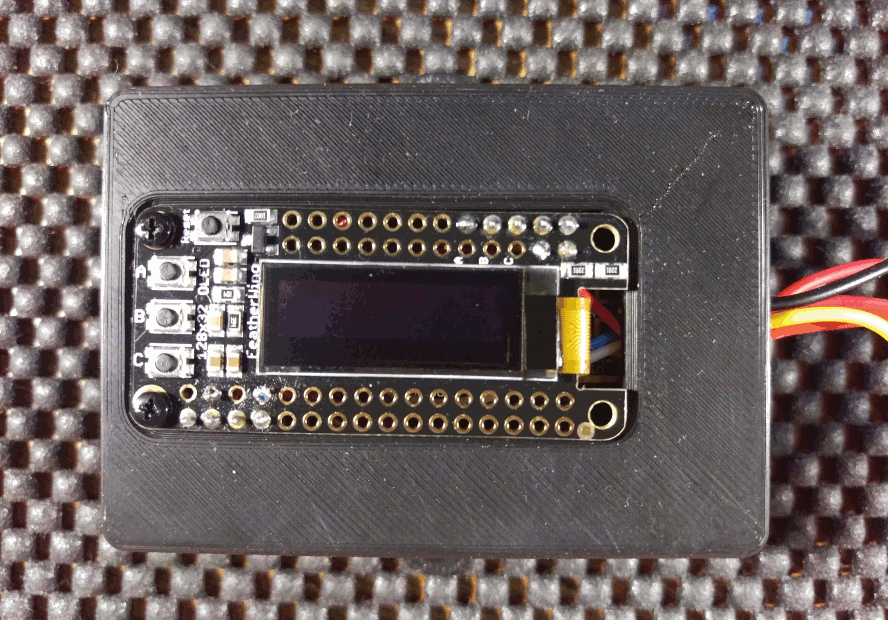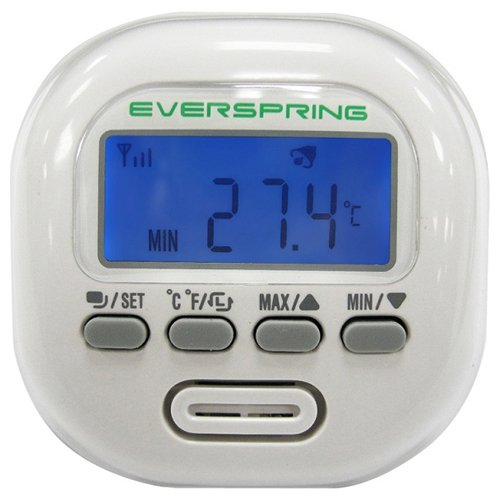This is a firmware application written in C++ using Arduino and Adafruit libraries. It monitors time, temperature, humidity, battery voltage, and current. Sensor readings are posted to io.adafruit.com using MQTT. Readings can also be obtained on the Feather OLED (SSD1306) using the contact switches. This project is a near-clone of ESP8266 Adafruit Huzzah Monitor. I built it because the Feather M0 offers dramatically lower (~2mA) sleep-time power consumption compared to the ESP8266 Huzzah.
I own two Everspring Z-Wave Wireless Temperature and Humidity sensors. Apparently they are no longer being made. At least I couldn't find any for sale, so I decided to build something similar myself. The Everspring provides temperature and humidity readings. It can post this data via Z-Wave to a hub. Mine run for about a year on three lithium AAA batteries.My replacement uses off-the-shelf bits I bought from the good folks at Adafruit Industries. Like the Everspring my device has a nice plastic case. The bottom compartment of that case holds a 2500mAh Lithium Ion Polymer Battery. The battery is connected to an on/off switch using a cable and a connector. That plugs into the ESP8266 Huzzah module sitting in the middle part of the case. The temperature and humidity readings are given by a DHT22 (AM3202) sensor. The current readings come from an INA219. The display and push buttons are the Feather OLED. I built my own voltage divider to provide the battery voltage. The details of that are on the schematic:
All put together it looks like this:
The size of the DHT22 is a bit large but quite acceptable given its more accurate than the smaller siblings in the same sensor family. The red and black extension cord has the JST-HXP connectors used by my experiments. Its connected to the inputs of the current sensor. The lid of the box is the top part of the case. The blue cable on the left connects to a USB charger to top-up the battery.
I used the platformio build system with JetBrains CLion to build this project. If you plan to do so you'll need a platformio.ini file of your own. I excluded mine from this repo because it contains all my secrets. I define build_flags for secrets like my WiFi password and io.adafruit.com key. This keeps them together and out of the source code for improved security and ease of management. You can build you own using this template:
; PlatformIO Project Configuration File
;
; Build options: build flags, source filter
; Upload options: custom upload port, speed and extra flags
; Library options: dependencies, extra library storages
; Advanced options: extra scripting
;
; Please visit documentation for the other options and examples
; http://docs.platformio.org/page/projectconf.html
[platformio]
[common]
lib_deps_external =
https://github.com/patrickmoffitt/Adafruit-MQT-Library-Large-Sub.git
https://github.com/adafruit/Adafruit-GFX-Library/archive/master.zip
https://github.com/adafruit/Adafruit_FeatherOLED/archive/master.zip
https://github.com/adafruit/Adafruit_SSD1306/archive/master.zip
https://github.com/adafruit/Adafruit_Sensor/archive/master.zip
https://github.com/adafruit/DHT-sensor-library/archive/master.zip
https://github.com/adafruit/Adafruit_INA219/archive/master.zip
https://github.com/arduino-libraries/RTCZero.git
[env:adafruit_feather_m0]
platform = atmelsam
board = adafruit_feather_m0
framework = arduino
upload_port = /full/path/to/your/USB-TTL-DEVICE
upload_speed = 921699
lib_deps =
${common.lib_deps_external}
build_flags =
'-DGMT_OFFSET=-5'
'-DWIFI_SSID="WiFi_AP_SSID"'
'-DWIFI_PASS="WiFi Password"'
'-DWIFI_MAC_ADDR={0xE0, 0x9A, 0x4C, 0xB5, 0x5F, 0xC7}'
'-DAIO_USERNAME="adafruit_user_name"'
'-DAIO_KEY="dafruit_user_key"'
'-DAIO_SERVER="io.adafruit.com"'
'-DAIO_SERVERPORT=8883'
'-DAIO_FLOAT_PRECISION=2'
'-DAIO_GROUP_KEY="monitor-two"'
'-DAIO_MQTT_PAYLOAD_FLOAT_MAX_SIZE=6'
You may want to redefine the following:
- GMT_OFFSET — The number of hours (or fraction thereof) your timezone is offset from UTC/GMT.
- WIFI_SSID — Your WiFi access point's Service Set Identifier (SSID) or name.
- WIFI_PASS — Your WiFi access point's password.
- WIFI_MAC_ADDR — The six digit ethernet address of your ESP8266. I assign it so that it will matchup with my DHCP server's configuration. I assign it a fixed IP based upon it's Medium Access Controller (MAC) address.
- AIO_USERNAME — Your Adafruit IO username.
- AIO_KEY — Your Adafruit IO key (click the AIO Key button on a dashboard to find the key).
- AIO_SERVERPORT — The AIO server port. 8883 is correct for SSL clients.
- AIO_FLOAT_PRECISION — The number of decimal places to send to your feeds. The API only sends strings. This number determines how many decimal places are kept when floats are converted to strings for sending.
- AIO_GROUP_KEY — If your feeds are grouped, put the group name here.
- AIO_MQTT_PAYLOAD_FLOAT_MAX_SIZE — The API supports up to 29. Save memory by defining a lower value if you can.
I hope these notes will help to explain some software design and implementation details which might not otherwise be immediately apparent.
This application uses the ATWINC1500 to set the clock. Since the
Atmel SAMD21 has no persistent clock, the time must be set upon booting or waking the
system. I couldn't find a
locale
library to handle timezones and
Daylight Saving
Time (DST) for this project so I wrote my own. It only works for the Eastern
timezone. You can modify it for your own locale by updating the DST start and
end dates in the ntp_time_utils::dst_dates map. Also change the timezone
abbreviation in ntp_time_utils::set_dst_usa.
The voltage is read by get_battery_vdc() in monitor_read_battery.cpp. This
function reads the ADC pin 30 times in one second and averages the results
together. The readings fluctuate based upon WiFi activity. Polling averages away
those fluctuations.
The ATWINC1500 does this auto-magically. All you have to do is load up the SSL certificates.
In order to save battery I have disabled the green and yellow LEDs on the WiFi module. This is done in lib/WiFi101/src/bsp/include/nm_bsp_internal.h by preventing CONF_PERIPH from being defined. If you'd rather have those blinking lights I suggest you remove lib/WiFi101 and load <WiFi101.h> (the Arduino version) in main.cpp instead.
If you find a bug please create an issue. If you'd like to contribute please send a pull request.



